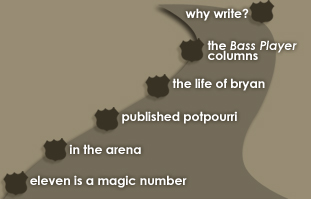
 |
|||||||||
|
|
|||||||||
| Sign up for BellerBytes, the official (and private) Bryan Beller e-newsletter. Just click here to sign up. Do it, OK? | |||||||||
|
Column
#6: The Meaning of NAMM The NAMM show. What it is depends on how you feel about what you know. Sure, you’ve seen the NAMM articles in Bass Player. They inevitably contain pictures of gleaming new equipment and live shots of jam sessions featuring impossible combinations of players, with throngs of music lovers milling around in awe. The overwhelming spirit of pure music brings together disparate groups from all around the world in a semiannual celebration of … well, what exactly? NAMM stands for the National Association of Music Merchants--the most important word being merchants. Only a value as universal as commerce could bring together the owner of a small Iowa music store, the head buyer for Guitar Center, the gear freak who got in through his friend at Alesis, the Bass Player Editor in Chief, a West Virginia sales rep, Peavey’s CEO, and a hundred of the world’s most talented musicians--all of whom pack into a noisy convention hall in downtown Los Angeles for four days. NAMM is not open to the public. This is no street fair. Serious business is conducted there, and only the properly credentialed shall pass. Still, restricted access or not, it’s a mob scene--by Saturday you can barely walk the aisles without getting caught in someone’s hair. Actually, it’s more of a mob circle, jet-propelled by five distinct factions that chase each other around until the resulting commercial sphere hums and spins in a Contact-like frenzy. Manufacturers. They’re at the top of the circle. They’re the ones who actually rent the hall’s floor space, square foot by bloody square foot. Everyone from Fender and Korg to the most obscure South Dakota luthier have been busting their asses for months leading up to the show, slaving over the products they hope will change the world--and their fortunes. Success comes in the form of a new commitment from Sam Ash to carry a new active bass, a buzzing crowd around the booth, a high-profile player choosing to endorse a flagship amp, and a favorable magazine review. Failure is an empty booth, with people pointing and laughing at “radical” new designs as they walk by. Or, even worse, maybe the instruments don’t get noticed at all. All that money a company spends flying people and gear to L.A., the hotels, the airfare, the square feet--believe me, it’s a risk for any company just to attend. The manufacturers touch every part of the circle, because their booths are the islands in the sea of humanity in constant motion. And it’s their show. But in the end, they’re chasing one group most: Dealers. So these guys must have it easy--they just walk around, smiling and winking, waiting for the best manufacturer deal to come their way, right? Not if they’re an independent store struggling to stay alive after the MARS Superstore opened just two miles away. Not if they’re a chain whose main competitor has just bought a nationwide mail-order catalog. And especially not if their store doesn’t have the products customers want this year. No dealer can carry every manufacturer’s product line; a dealer must choose which products and brands best suit its local (or nationwide) customer base. Dealers have to meet commitments to sell certain amounts of product to remain an Authorized Dealer for So-and-So, which they promise to do in meetings throughout the show. They have to keep turnover rapid to generate enough cash to pay for the next quarterly purchase, already committed to in last year’s meeting. And they have to do it all with a smile on their face, because they’re at ground zero chasing the … Customers. Without them, there is nothing. They are the part of the circle that drives the rest crazy, because they’re fickle and--whether they realize it or not--totally in control, because it’s their money that everyone’s after. Ironically, though, they’re largely unrepresented at NAMM; only a small percentage get in. Still, a customer crashing NAMM is fairly easy to spot: a visitor badge, a camera, a perma-grin, and lots of pointing. Their legs are weary--but never too tired to chase down an autograph and picture of their favorite … Endorsers. An endorser’s view of NAMM is slightly skewed. No one else is getting anything free here, but that’s exactly what an endorser is after: accommodation befitting that of a busy, professional musician. They also cruise the show looking for promotion opportunities. Manufacturers and dealers both know nothing sells a piece of gear like their customers’ heroes using the new model that just happens to be in the window this month. So endorsers are essential to the NAMM circle: a manufacturer offers a special deal to an endorser, who then attracts customers to the booth, which attracts the attention of dealers who see their customers freaking out. And hopefully, the endorsers cause enough commotion to be noticed by the one faction they seek out more than anything: Press. That’s right--Bass Player, Guitar Player, Keyboard, Saxophone Weekly, you name it. They’re on hand to capture NAMM in pictures and words and report it to the masses. But their goals are not completely altruistic--they can’t be, or they wouldn’t fit into the circle of commerce. They’ve got bills to pay just like everyone else. As with the other factions, the customers drive their business through subscriptions--but if that alone paid the printing and mailing bills, magazines wouldn’t need advertisements. And who pays for the ads? The same people who bought the space on the convention floor--the manufacturers. Don’t get the wrong idea. This isn’t a screed against NAMM’s blatant capitalism. Quite the contrary; the market has a way of balancing things out. Manufacturers can’t sell a product to a market that doesn’t want it, no matter how great, awful, cheap, or profitable it is. Dealers can’t survive by dictating to customers what brands they must buy. Endorsers lose credibility if they appear in six different ads for competing manufacturers within a year. Magazines must maintain objectivity despite the potential conflict of incoming ad revenue, or else the readership loses trust and circulation nosedives. Overall, the customers enforce abuse of the competitive impulse, especially when their pocketbooks are affected. On the other hand, if Manufacturer A makes something great that the market can afford, the dealers will compete with each other to stock it, the customers will buy it, an endorser or two will use it on tour, and New Gear Monthly will report that Joey Schlabotnik (whose mug is on the cover) is a damn good musician who uses the Great New Product X. Then Manufacturer B does A one better with an Even Better New Product Y, which they advertise heavily in New Gear Monthly, and the whole thing starts all over again. Everybody wins, and money flies like rice at a wedding. So what does that make NAMM? Certainly more than a series of flashy photo ops. At the very least, it’s a gathering of folks drawn together by business, gear, and music, in that order. But more than likely, it’s a microcosm of … well, that’s for you to decide. By Bryan Beller, copyright 2000 United Entertainment Media. Reprinted from the July, 2000 issue of BASS PLAYER. Reprinted with permission from BASS PLAYER. For subscription information, please call (850) 682-7644 or visit www.bassplayer.com |

|